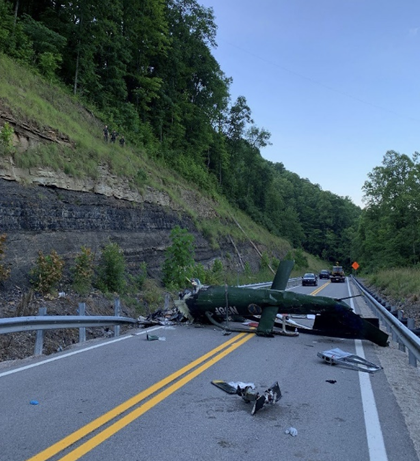


A vintage helicopter crash associated with the annual Huey reunion event, that killed six occupants more than two years ago in Logan County, was caused partly by inadequate inspections on the helicopter, the National Transportation Safety Board (NTSB) said in a report released Tuesday.
The June 22, 2022, crash of a Bell Helicopter UH-1B in Amherstdale, West Virginia, occurred after the rotorcraft hit powerlines during an attempted forced landing after a loss of engine power. Investigators determined the loss of power was due to the failure of an engine component.
The Bell UH-1B helicopter, also known as a Vietnam War-era Huey, crashed on June 22, 2022, in Amherstdale, West Virginia. The helicopter had been offering rides to people attending a Huey reunion event at Logan County Airport and sponsored by MARPAT Aviation.
“The NTSB said the helicopter’s operator, MARPAT Aviation, would likely have discovered the fatigue cracks and other engine damage that led to the failure of the engine component had it done more comprehensive inspections of the UH-1B helicopter, also known as a ‘Huey,’ "
Inadequate inspections by the operator and a lack of safety oversight by the Federal Aviation Administration were among primary causes to blame for the crash of a Vietnam-era tourist helicopter in West Virginia two years ago, according to a final report released Tuesday.
The Bell UH-1B “Huey” helicopter lost engine power and struck power lines during an attempted forced landing in June 2022 in Amherstdale, the National Transportation Safety Board said.
The helicopter, which had taken off 15 minutes earlier from Logan County Airport, then smashed into a rock face and caught fire near a road.
The final investigation report states,
“the FAA provided ‘basically no oversight’ of MARPAT Aviation. The NTSB noted that the FAA lacked guidance for inspectors to perform routine surveillance of operators with experimental airworthiness certificates.”
According to the NTSB, the FAA issued a “special airworthiness certificate in the ‘experimental exhibition’ category” for the Huey helicopter in December 2014.
They said the FAA shouldn’t have allowed it to be inspected and maintained due to the requirements at the time not ensuring the airworthiness of the aircraft and operation.
“The NTSB said that the FAA should not have allowed the helicopter to be inspected and maintained according to the requirements that were in place at the time, which were insufficient to ensure the airworthiness of the aircraft and operation,” the NTSB report states.
The agency added further to the report, “more robust inspection standards” for former military aircraft were put in place by February 2015, but they didn’t apply to the Huey that crashed because its airworthiness certificate had been issued just months earlier.
“MARPAT Aviation had previously inspected and maintained the accident helicopter to more comprehensive inspection standards when it was operated under a restricted-category airworthiness certificate, most recently between October 2013 and December 2014,” the NTSB said.
“Even though the operator wasn’t required to continue to use the more stringent inspection standards, the NTSB said that ‘MARPAT Aviation’s decision not to use more rigorous inspection standards when the helicopter was operated under an experimental category certificate was also a factor that led to the accident.’ "
NTSB Investigators found that a component failure caused the loss of engine power. More comprehensive inspections by operator MARPAT Aviation, a Logan County flight school, likely would have uncovered fatigue cracks and other engine damage that led to the component's failure, the NTSB said in a statement.
The NTSB said the FAA provided “basically no oversight” of MARPAT Aviation. At the time, the helicopter operated under a “special airworthiness certificate” in an experimental exhibition category.
The airworthiness certificate was issued in December 2014 by the FAA's flight standards district office in Charleston. The NTSB also mentioned that the FAA lacked guidance for inspectors to perform routine surveillance of operators with experimental airworthiness certificates.
Display Photo: NTSB
